Last Updated on October 17, 2023
Start your own medicinal herb garden with these 3 easy to grow medicinal plants.
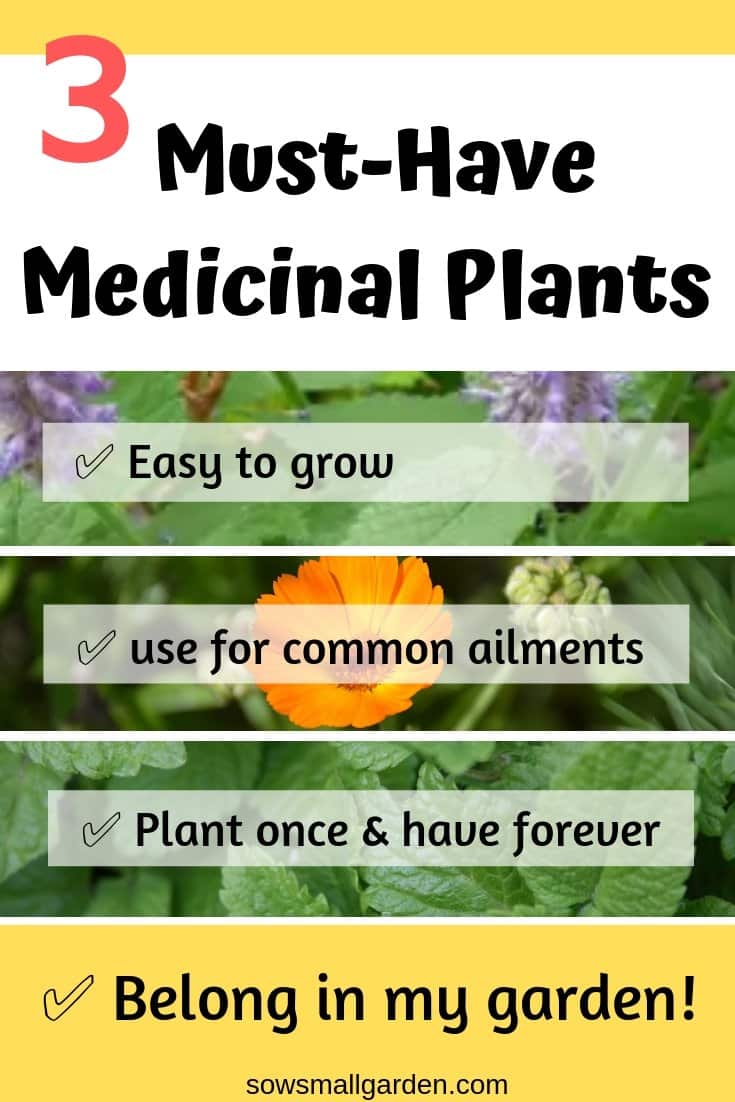
*This post contains affiliate links. If you choose to purchase any of the products I have recommended, I may receive a commission at no cost to you.
Why grow your own medicinal plants instead of buying ready made herbal supplements?
I like to grow my own medicinal plants in order to ensure authenticity of healing herbs, have a fresh supply of medicinal plants on hand when needed, and just because I love to have a connection with the things that nourish my body.
But still – the main reason for me is concern about the authenticity of a product.
When I moved to the U.S.A. and decided to buy herbs in bulk from a local health store – dried German chamomile flowers and linden flowers – I was sold wrong products, and it was something that I was able to see and clearly identify unlike a supplement in the pill form or crushed herbal tea in the package.
You see, because herbal remedies are not regulated by FDA (Food and Drug Administration), when we are buying prepared and packaged medicinal teas and herbal supplements there is no way to know that what is written on the label is indeed the herb that we are getting. When buying a supplement, we just rely on the honesty of the company producing it.
But should we be so trusty?
According to a CBS news report about the results of an investigation led by New York Attorney General Eric Schneiderman, only 21 percent of the herbal supplements from four major retailers: GNC, Target, Walmart and Walgreen actually had DNA from the plants advertised on the labels. When looking at Walmart numbers alone – it is even scarier: only 4 percent of the products tested showed DNA from the plants listed on the labels.
Useful Tip
When buying herbal supplements, always look for the words ‘standardized extract’ on the label to ensure the potency of the major active ingredients of the medicinal plants.
A good thing is that you can grow your own medicinal plants in your garden or in pots on your patio. Some of them are very easy to grow and help with a lot of common ailments.
Is herbal medicine safe?
A word of caution before we proceed: herbal medicine is not risk free.
Herbs have medication like effects: they can heal and harm, especially in large or repeated doses.
They also can interact with prescription medications. It is recommended to consult your doctor before taking herbal supplements, especially if you take medications, are pregnant or breastfeeding, or have chronic health problems.
Before using any herb you should be able to identify it correctly. I, personally, would stay away from herbs grown in the wild, because there are a lot of look alike plants that can be harmful.
And, as with everything else in life, when dealing with herbs – use common sense.
Useful Tip
Before using herbs, investigate the potential benefits and side effects of medicinal plants or herbal supplements A good place that will provide you with research-based information is National Center for Complementary and Integrative Health and the Office of Dietary Supplements of National Institutes of Health.
Why did I choose these 3 medicinal plants for a medicinal herb garden?
My friend knows – I love my medicinal herbs, can not do without them!
So, one day we were talking and she asked me, “What if you were allowed to plant just 3 medicinal plants, which ones would you choose?”
I told her, that it is impossible, I need to have at least 10 to cover all common ailments.
“No”, she insisted. “You should pick no more than 3, because the lack of space, or time, or any other constraint, it’s your challenge!”
OK, I love challenges…
So, I thought for a while for plant choice criteria and decided that I would want plants that
- are easy to grow. Plant once and have supply forever
- have a long growing season, so fresh material for natural remedies is available as long as possible during the year
- used by me most frequently
- exhibit antiviral and antibacterial properties backed by scientific research
- can help with the most common ailments (combined between 3 of them)
- act upon the body in the safest and gentle way with no side effects reported
Considering my criteria I came up with 3 winners:
Korean mint – helps with ailments inside the body.
Calendula – first aid for wounds and cuts, used for everything on the surface of the body as well as inside the mouth and throat.
Lemon balm – aids with mental well-being by reducing stress and relieving anxiety.
All 3 plants also exhibit antibacterial, antimicrobial, and antiviral properties. All are great antioxidants and are suitable for more than just medicinal uses.
They are all easy to grow.
Korean mint and lemon balm are perennials.
Calendula, though annual, will grow year after year if you give it a dedicated patch in the garden or container and allow it to reseed naturally.
I am aware that you might have different needs.
You can create your own criteria for the choice of medicinal plants and pick the ones that suit your needs. (Get ideas on what you can grow from 40 Herbs for your garden.)
You can start small – with just 3 plants, and expand your healing herb garden with time.
1. Korean Mint (Latin name – Agastache rugosa)
The best medicinal plant for stomachache or any digestive problems.
How to grow Korean mint
Korean mint, also known as purple giant hyssop, huo xiang, or blue licorice, is a hardy prolific perennial that is deer and rabbit resistant. Be aware that Korean mint can become invasive.
It can grow almost in any soil, and is happy when planted in a container on your patio or balcony. It overwinters just fine in open soil or in the pot when left outdoors in zones 4 – 9.
Korean mint can grow to 3-4 feet tall, likes sun, but will take a partial shade.
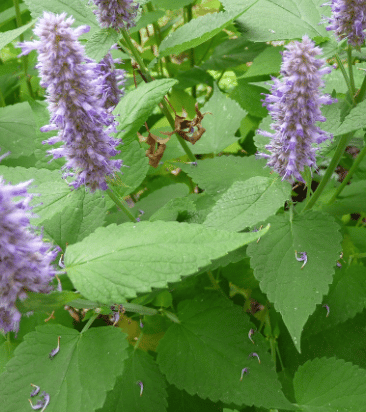
Korean mint (Agastache rugosa)
It blooms profusely by producing spikes with pretty lavender flowers from June till mid-autumn and attracts lots of bees.
Korean mint will grow from seeds, plant division, or from cuttings.
The seeds need light to germinate – so the best it just to scatter them on the top of the soil, tightly press into the soil with your palm , and water with warm water.

You can start to grow seedlings indoors in late February and replant them outdoors after the danger of last frost passes, or sow seeds in open soil after danger of frost passes.
After you grow your first Korean mint plant and let it to reseed itself – you will have an endless supply of healing leaves for years to come.
Agastache rugosa medicinal properties
Korean mint (Agastache rugosa) is one of the 50 fundamental medicinal plants used in traditional Chinese medicine.
In Taiwan it is the #1 remedy for stomach discomfort.
Korean mint leaf water extract is one of the ingredients of herbal preparation that is effective against HRV (human rotavirus) infection. Study shows that Korean mint helps to stop diarrhea in mice caused by virus.
It also has been among the 10 most popular traditional Chinese medicines prescribed in Taiwan for hepatitis.
In oriental medicinal practice preparations that include Korean mint have been reported to exhibit anti-inflammatory, anti-microbial, anti-allergy and anticancer activity on human skin.
According to recent scientific studies Agastache rugosa inhibits inflammatory activity, It also has anti-viral, anti-fungal, and anti-bacterial properties.
Another study shows very promising potential of A. rugosa constituents in chemo-prevention. The research reports antimicrobial and anti-mutagenic effects of Korean mint . It also mentions that preparation containing essential oil from Agastache rugosa was remarkably efficient in alleviating heat stress symptoms.
In Russia, Korean mint is famous for antioxidant and anti-aging properties. It believed to be good for general purification of the body, getting rid of heavy metals, reducing the risk of developing inflammatory processes, elimination of infections caused by bacteria, and for restoration of male potency.
.
How to use Korean mint
The leaves of Korean mint are edible and some people use them in salads, but the leaves have coarse texture and too strong smell as to my liking, so I do not use them for culinary purposes. When a leaf is crushed – it smells like licorice and mint combined. It odorizes the house with fresh scent. In Korea the leaves are used in fish stews.
The easiest way to use Korean mint for medicinal purposes, is to make a tea from fresh or dried leaves.
Korean mint tea recipe
- Place around 2 tablespoons of chopped fresh Korean mint leaves ( or 1 tablespoon of crushed dried leaves) in a cup.
- Pour 1 cup of boiling water over the leaves. Cover the cup.
- Let it steep for 10 minutes.
- Strain.
You can enjoy this tea once a day just for a pleasant drink. For medicinal purposes it is recommended to drink half cup of this tea 3 times per day 20 minutes before meals.
2. Calendula (Latin name – Calendula officinalis)
First aid remedy for cuts and wounds anywhere on the skin or in the mouth.
How to grow calendula
Calendula – is one of the easiest plants to grow.
It loves full sun, but will grow in partial shade in the garden or container.
You can sow it in open ground after the danger of frost passes or start seeds indoors and replant seedlings in open ground in late April.
When your plants get established, you can collect your own seeds in the autumn and plant them the next year.
Alternatively, you can let plants reseed themselves. Though calendula is an annual, by giving it a dedicated place in your garden or container on your deck, and letting seeds fall on the ground – calendula will take care of its own growth and will greet you next year with cheery yellow-orange flowers.

Please, read my article How to grow calendula that offers detailed planting instructions and advice.
Calendula Medicinal Properties
I have another article dedicated to the calendula medicinal properties in which I describe them in great detail. So, I will quickly recap here what calendula can treat due to its antiviral, antibacterial, antifungal, anti-inflammatory, antioxidant, antigenotoxic, hepatoprotective, and wound healing properties.
Calendula if used topically is:
- first aid remedy for wounds, cuts, scrapes, swelling, inflammation on the skin and inside the mouth
- applied to the skin to reduce pain and swelling (inflammation) and to treat poorly healing wounds and leg ulcers, nosebleeds, varicose veins, hemorrhoids, ear infection, yeast infection, gum disease, peeling lips, diaper rash, and conjunctivitis.
- treats acne
- gargle for sore throat
- insect repellent
Calendula is used internally for:
- menstrual cramps, stomach ulcers, measles, smallpox, and jaundice
- effective against flu and herpes viruses, helps body to fight pathogens
- removes toxins from lymph system, reduces lymphatic congestion and infection
How to use calendula
For medicinal purposes fresh or dried calendula flowers are used.
If you are going to dry your own flowers – early summer is the best time to pick them to ensure their peak healing properties.
Please, read my Calendula Healing Properties article and Calendula Recipes: 4 DIY Remedies for Home Use where I describe healing power of calendula flowers and explain how to prepare and use calendula tincture, infused oil, salve, and calendula tea.
3. Lemon balm (Latin name – Melissa officinalis)
medicinal plant to reduce stress and anxiety and to improve your mood

How to grow lemon balm
Lemon balm is a cold hardy and easy to grow perennial that can survive 20° F.
It grows well in open soil and in pots. Lemon balm prefers full sun and moist soil. If you let it self-seed – the plant can become invasive.
In its growing habits, melissa is very much like Korean mint. You can grow melissa from seeds sown in open ground in spring, or start seedlings indoors in late winter and replant them in spring. Well-established plants can be divided.

To harvest lemon balm for medicinal tea, simply take clippings as needed from your plants or pluck individual young leaves. The newest growth is the most flavorful.
You can dry melissa using different methods: shade drying, sun drying, and oven drying at 100° F (40° C)
Useful Tip
The research shows that “fresh lemon balm herb had the highest essential oil content followed by shade drying, oven drying and sun drying respectively… Drying methods had no effect on the number of chemical components of the essential oil, as 43 components were identified in the essential oil of each drying method. ”
Lemon balm medicinal properties
Called by Paracelsus “the elixir of life”, lemon balm (Melissa Officinalis) has been known for centuries for its calming properties.
Melissa reduces cortisol (stress hormone) and relaxes the body without causing drowsiness.
Lemon balm also helps to elevate the mood. This might be partially explained by strong lemon scent of melissa’s leaves. A scientific experiment that studied olfactory influences on mood “provided robust evidence that lemon oil reliably enhances positive mood compared to water and lavender regardless of expectancies or previous use of aromatherapy.”
According to recent research, lemon balm exhibits anitimicrobial activity (antiparasitic, antibacterial, antiviral), as well as antioxidant, antitumoral properties.
Melissa officinalis oil is suitable for topical treatment of herpetic infections.
As a medicinal plant, lemon balm:
- relaxes body
- relieve stress and anxiety, promotes calmness, acting as mild sedative
- lifts mood
- improves sleep
- eases digestive disorders – gas, bloating, colic
- fights herpes, and heals cold sores caused by herpes
- reduces fever
- enhances memory
How to use lemon balm
You can put melissa young leaves in salads, use it to make lemony salad dressing or marinade, or swap basil for lemon balm leaves in your favorite pesto recipe.
For making medicinal tea from lemon balm:
- Place a few fresh lemon balm leaves (or 1 teaspoon of dried crushed leaves) in a cup
- Pour 1 cup of boiling water over the leaves. Cover the cup to preserve essential oil.
- Let it steep for 5-10 minutes
- Strain.
Enjoy this flavorful lemony drink alone or add some honey to it.
Useful Tip
If you need short-term insect repellent while working in your garden – crush a few lemon balm leaves and rub them into your skin.
Alternatively, you can place a few washed lemon balm leaves in plain cold water and let it sit for 20 minutes. This way you will get water infused with lemony scent to drink. And it is better for your body than store bought water enhancers.
You can make lemon balm infused oil, tincture or salve at home by following general guidance for creating natural remedies in this article.
Note. Consult your doctor about taking lemon balm if you are using prescribed sedative drugs to avoid amplification of sedative effect. Also, be wary of taking it if you have any thyroid problems.
Where to buy medicinal plant seeds?
I have never seen a Korean mint plant sold at a nursery. To tell the truth, I didn’t see calendula or lemon balm plants for sale in the nursery either, but I guess depending on where you live you might find calendula or melissa to buy in the pot.
The easiest and cheapest way is to grow these plants from seeds. I strongly suggest getting organic seeds if you are using plants for medicinal purposes. Most likely you will need to order the seeds from a seed catalog or you can get them from Amazon. Below is a selection of organic Korean mint, calendula, and lemon balm seeds you can find on Amazon.
Unfortunately organic medicinal herb seeds from particular sellers are quite often out of stock on Amazon. So, if you click on the links above and they show that item is unavailable, just do your own search for organic Korean mint, calendula, or melissa (lemon balm) seeds.
Alternatively, you can buy organic Herbal Tea seeds variety pack. It includes organic non-GMO calendula and lemon balm seeds, as well as chamomile, lavender, mint, sage, basil, dandelion, leaf fennel, and echinacea seeds. Actually, this pack is a very good value for your money, and comes with 10 eco reusable plant markers and an eBook with growing tips and recipes.
Organic Herbal Tea Seeds Pack
Includes calendula, lemon balm + 8 more medicinal plant seeds
Some of the herbs plants can be even grown indoors in your AeroGarden.
Also, this kit can make a perfect gift for a special gardener in your life.
Related reading:
Discover more articles about herbs.
Final thoughts on medicinal plants
My 3 must have medicinal plants for a medicinal herb garden are Korean mint, calendula, and lemon balm.
I chose them because they are easy to grow – nearly foolproof for novice gardener. They also cover the majority of ailments that can be treated at home.
Calendula – is first aid for cuts, scrapes and swellings, a must medicinal plant for skin conditions.
Korean mint promotes healing inside the body.
Lemon balm helps to calm nerves.
All three plants heal the body in a gentle and powerful way. By planting these medicinal plants you can have a supply of natural remedies for years to come.
Which medicinal plants are you growing or planning to grow in your garden and why? Share in the comments.
And if you found this article useful – be so kind to share with friends.

You have read:


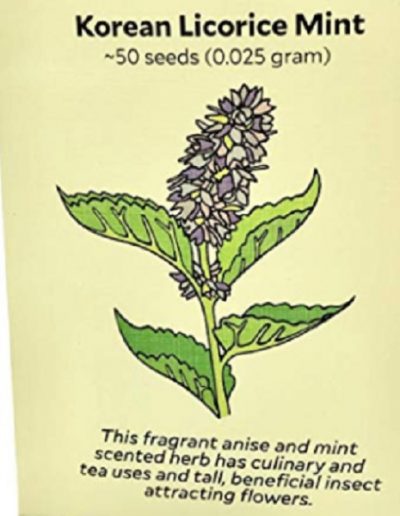

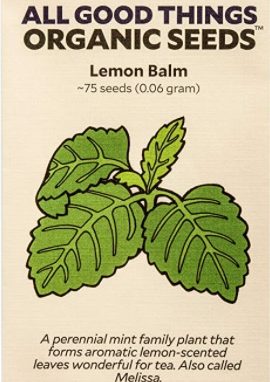



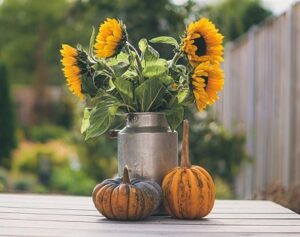
I live in Canada. Winters are fierce and at times brutal. Can I start/grow these Herbs indoors using a grow light then transplant them when the soil and temperatures are more friendly?
Hello Murray,
Yes, you can start any of these plants indoors under a grow light or in an AeroGarden 6-8 weeks before the last frost for your area and then replant them into your garden.
I have a separate article about growing calendula. Just scroll to “Starting calendula plants indoors” for more information.
https://sowsmallgarden.com/how-to-grow-calendula/
Or check out my other reference article about 40 culinary and medicinal herbs you can grow in your garden which provides short information on how to start seeds indoors for each plant.
https://sowsmallgarden.com/herbs-for-a-garden/
Happy gardening!
Want to start an indoor garden of medicinal herbs.
Hi Ramona,
Here are some tips for starting an indoor garden of medicinal plants:
1. Research: Familiarize yourself with the different types of medicinal plants and their specific growing requirements, such as sunlight, water, and soil type.
2. Space: Choose a sunny room with ample space for your plants to grow and enough light to support photosynthesis. Alternatively, you can grow your medicinal plants indoor in AeroGarden. https://sowsmallgarden.com/best-aerogarden-reviews/
3. Containers: Select containers that are appropriate for the size of your plants, have good drainage, and are made of materials that won’t react with soil or water.
4. Soil: Use high-quality, well-draining soil specifically formulated for indoor plants. https://amzn.to/40o8R1Q
5. Watering: Water your plants regularly, but don’t over-water them. Over-watering can lead to root rot and other problems.
6. Temperature: Most medicinal plants thrive in temperatures between 65 and 75°F. Maintain this temperature range as much as possible in your indoor garden.
7. Pest control: Be mindful of common indoor pests, such as spider mites and aphids, and take steps to control them if they appear.
8. Harvesting: When harvesting leaves or other parts of medicinal plants, do so in a responsible and sustainable manner to avoid damaging the plant.
9. Safety: Some medicinal plants can be toxic, so be sure to research the safety of each plant before adding it to your garden, and follow proper handling and storage guidelines.
Remember, starting an indoor garden is a fun and rewarding hobby, but it does require patience, attention, and effort. Happy planting!